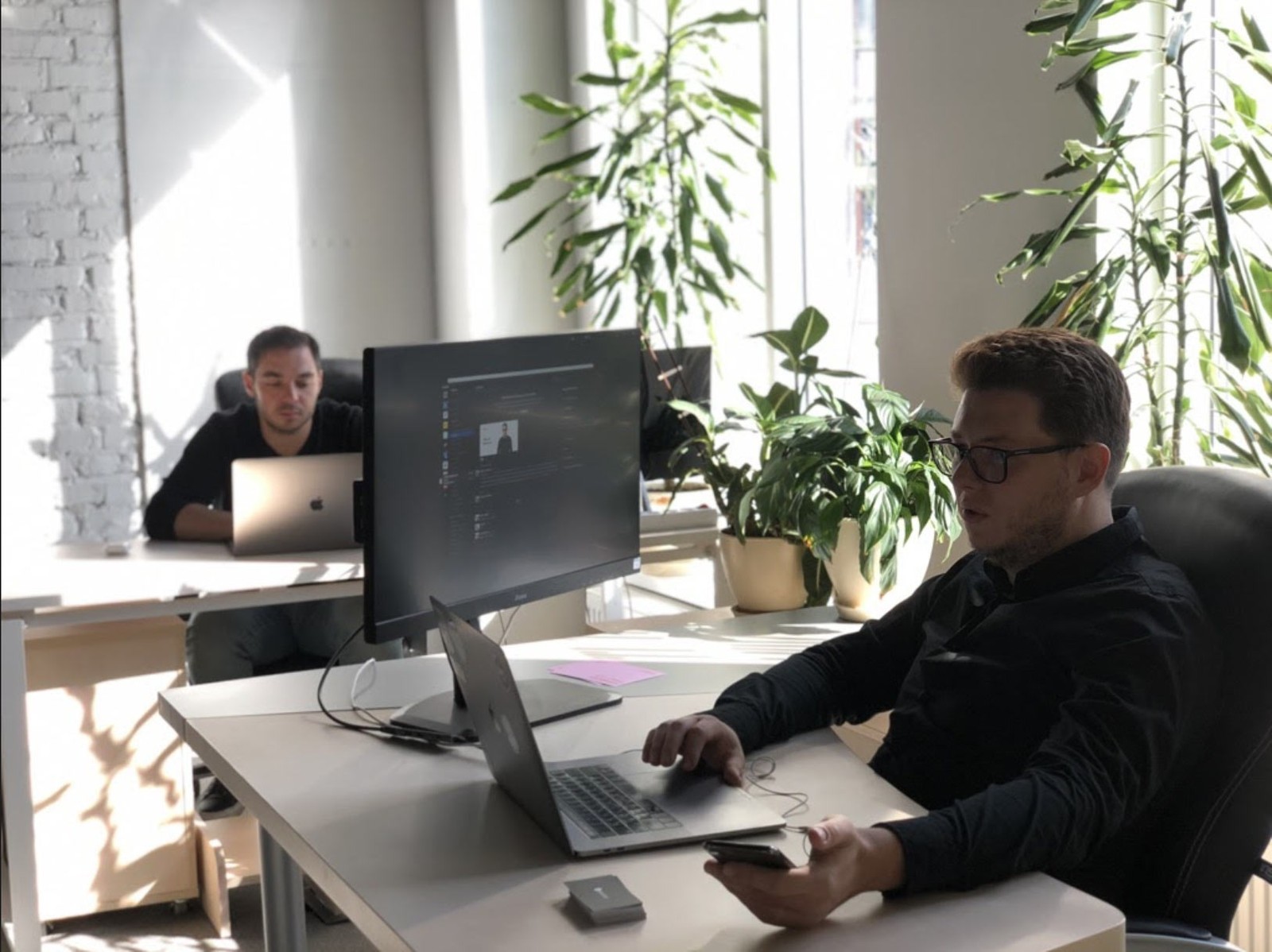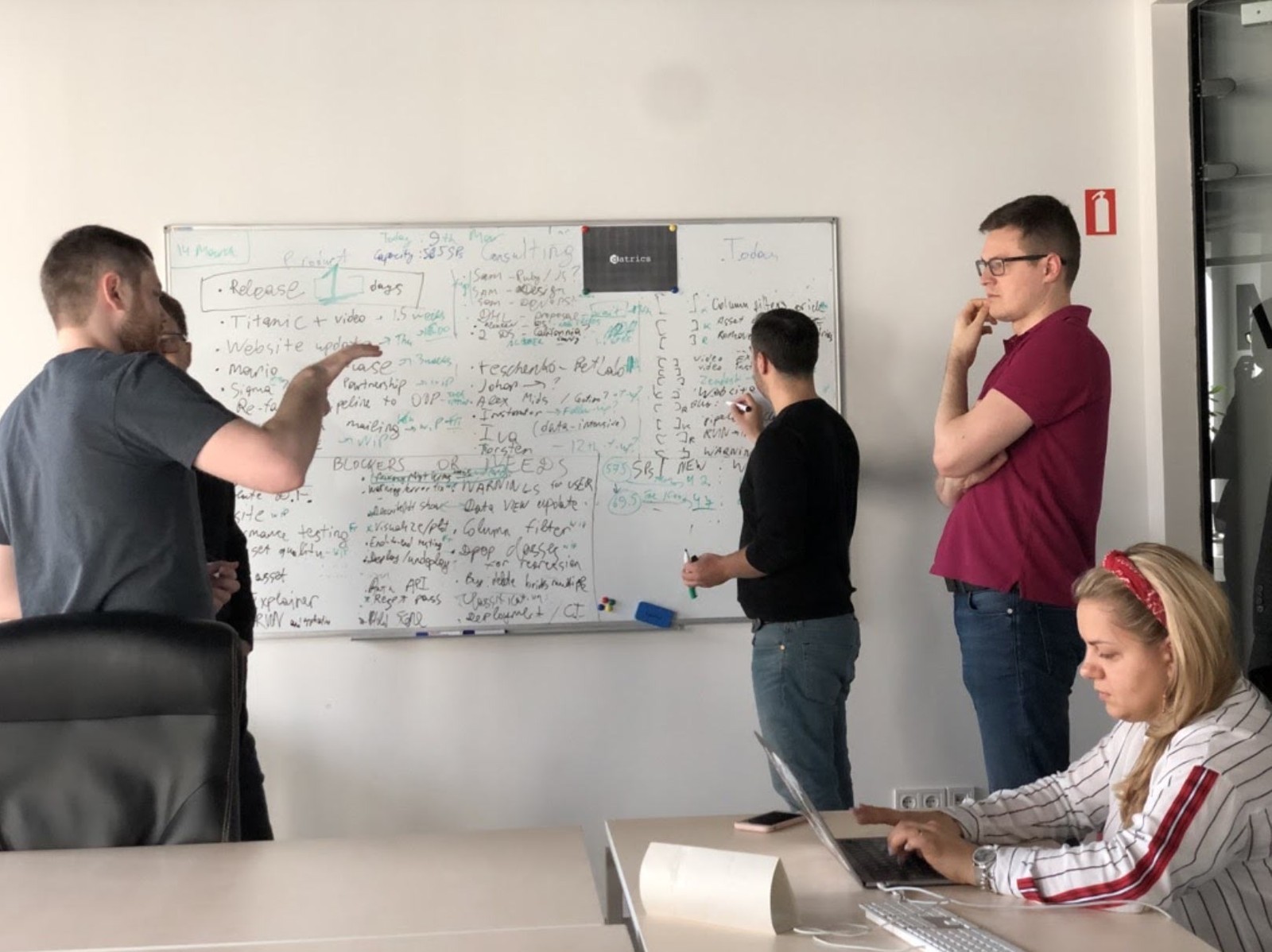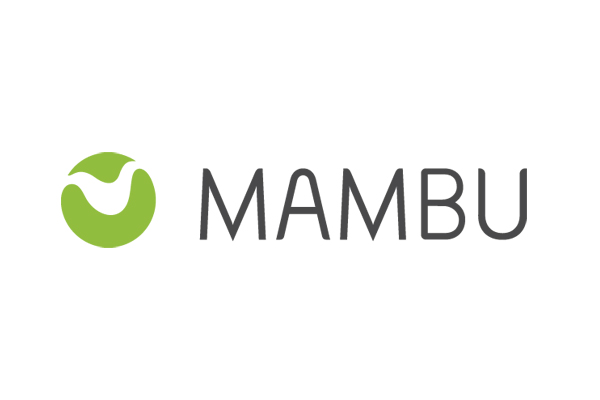Anton Vaisburd, Datrics.ai co-founder. The story of Corezoid, Barclays, Y Combintor and 50 million business-analysts.

|
|---|
| Anton Vaisburd, Datrics.ai co-founder |
Anton, where were you born and raised?
I was born and spent most of my life in Kharkiv, Ukraine. I studied at the Faculty of Mechanics and Mathematics of the V.N.Karazin University. I've always been fond of mathematics. My mother and I created an Olympiad mathematics studio for children in Kharkiv, and it still works. Almost 3,000 kids are studying there every month.

|
|---|
| Children study at “Fizmatic” studio in Kharkiv |
Did you personally win any tournaments?
Yes. I have won the Ukrainian Mathematical Olympiad 4 times. And there were also tournaments, math-battles in Ukraine, Russia. Then I went for a short time to study in Sweden, in the city of Växjö, studying mathematics in relation to finance. I became interested in the topic of liquidity risk management, financial models. At one point, I got a job at Barclays, led a team of analysts, studied predictive models.
Then you returned to Ukraine?
Yes. I started working for the Softserve company. In 3 years my team has grown from 3 to 30 people. And I thought: "Why is there such a rapid growth?" I realized that almost any business process in a large organization can be improved with the help of analytics and machine learning. For example, lending, inventory management, marketing campaigns.
Could you give some examples?
How a decision to issue a loan is made in large companies? These are very simple rules: a few calls to the credit bureau, a basic analysis of the client's profile, and that's it. But you can work much more efficiently. For one of Datrics' clients, we have increased the quality of his loan portfolio by 40% through machine learning and more sophisticated math models.
I can also give You an example from the inventory management space. How does a company manager understand how many pens, carts, and so on to order for sale? Often these decisions are made "manually". Manager looks at how much was sold last week, well, then you need to order the same amount for next week. Mathematical models allow us to make such decisions much more precisely.
There are not enough programmers in the whole world to build all those mathematical models that businesses need.
How the Datrics company was founded?
While working at Softserve, we saw how fast the demand for analytics and machine learning was growing. There are more and more projects where analysts and ML developers are in demand. Yes, companies can hire developers in Eastern Europe, in India, but still the number of developers is growing linearly and the demand is growing exponentially. There are not enough programmers in the whole world to build all those mathematical models that businesses need. We realized that this gap needs to be fulfilled somehow. Datrics is the solution to close that gap between supply and demand. We enable existing employees to work on mathematical models with minimal involvement of programmers and data scientists. With this idea, we created Datrics. First of all, we focused on machine learning for financial services, since our team already had experience in modeling financial risks.
We enable existing employees to work on mathematical models with minimal involvement of programmers and data scientists.
Who are the Datrics company founders?
We have 3 founders. I met Volodymyr Sofinsky 7 years ago while working at Barclays. Then we worked at Softserve together. I was in charge of P&L and operations management of our team, and Volodymyr was in charge of the data science part. Another co-founder is Kirill Kirikov, we have been friends for the last 13 years, since studying at the University in Kharkiv. Prior to joining Datrics, Kirill was a CTO and co-founder of 4irelabs, one of the outsourcing companies in Kyiv.

|
|---|
When was Datrics founded?
Formally, we incorporated in May 2020, but we began to develop ideas and create prototypes in 2019. Now we have 12 full-time employees, and we continue to hire several more employees per quarter. Basically, they are technical specialists. We have almost no random people in the team. We work with people whom we know personally from the university, from previous jobs.
Do you all work all together in the one office space?
No. We are building a completely online, decentralized, distributed team. People work from the USA, Indonesia, Ukraine.

|
|---|
Who was Your first client?
The first client came to us from the same outsourcing company in Kyiv, where Kirill Kirikov worked. His name is Mario, and we met at a time when we only had an idea of the product. Mario listened to us, nodded, and said that our pitch was awful, but he liked the idea. A few months later, Mario became our first client, and we became friends.
What problem did you solve?
We have developed algorithms for finding anomalies and predicting changes in cryptocurrency price quotes.
We reduce the time from raw data to getting value for business
Can Datrics technology be used in crypto-trading?
Yes. Datrics is a horizontal platform for different industries. We reduce the time from raw data to getting value for business. These can be insights, forecasts, more accurate calculations. Datrics has templates that can be easily modified and adapted to the specifics of the business. Of course, we have many templates for the financial services, in particular, for credit risk management.

|
|---|
How do customers start using Datrics?
Usually we make the first kick-off call. We start not with what Datrics does, but with what the client is doing, what are his goals and KPIs. After such a conversation, it becomes clear whether we can really help the client. If not, then we try to recommend a partner who can help.
If we see that Datrics can solve client's problem: save time, make more money, or something else, then we start discussing how we will work. We usually offer a free web-trial so that the client could upload his data sets (which can be depersonalized), try to do something with his data.
You can install Datrics anywhere: on premises or in any cloud. The data stays on customer servers and never leaves the company perimeter during the production use. We provide education, training, support. With each client, we have a dedicated communication channel to regularly check if everything is ok, understand the client's needs, develop additional features if the same requests keep coming from different clients.

|
|---|
Who is usually taking the decisions on the client side to use Datrics?
Our buyers are heads of businesses, heads of units, for example, the Head of Risk management. We say: "Your analytics and credit scoring iterations will cost 2 or 3 times cheaper, and You will launch 2 times faster." With Datrics, the customer integrates different data sources much faster and begins to get business value.
How long does it take to launch a project with a new client on average?
We launched projects with fintech companies in 4 days. Dealing with the banks is a more complicated thing. Even if the bank really wants to get started, then all the approvals take from 6 to 18 months.
Do you run the sales on your own or through the partners?
First of all, we do founder-driven sales. So far, no one can tell about the product better than ourselves. And no one will dive so deeply into the client's problems and create scalable solutions tailored to the client's needs. At the same time, Datrics has enough ready-made templates, for example, algorithms for credit risks modeling. In such cases we arrange the work through partner channels and system integrators who are able to work according to standard schemes.
In which countries does Datrics currently have projects?
The USA, the UK, Ukraine, Singapore.
Business analysts can work both with Datrics and Corezoid. I read a Gartner study which said that by 2024 65% of people in large enterprises will live in the low code\no code paradigm and will be able to use technologies such as Corezoid, Datrics, etc. And now there are only 1-2% of such people.
Anton, what do you like about Corezoid?
Datrics and Corezoid technologies rely upon the same ideological concepts. We are talking about business process automation. And I really like the idea of Corezoid, when a business process is decomposed into separate components. Each piece of the business process is a separate independent item, for which a dedicated employee is responsible, and it all adds up to such a huge live puzzle. Datrics could be one of the pieces of such a puzzle.
We are very comfortable integrating with Corezoid through the APIs. And we understand that there is no competition at all, our technologies complement each other. Actually, that's why we even made a template for integration with Datrics and published it on Corezoid Marketplace.
Business analysts can work both with Datrics and Corezoid. I read a Gartner study which said that by 2024 65% of people in large enterprises will live in the low code\no code paradigm and will be able to use technologies such as Corezoid, Datrics, etc. And now there are only 1-2% of such people.
And this is logical. There are not enough professional programmers in the whole world to solve all the problems that the business needs to solve.
In addition to the human resource factor, technological factors also play in our favor: there is no need to maintain a spaghetti-styled siloed legacy software, no need to puzzle over building the proper analytics, no need to throw complex technical specifications and bug reports from business to IT and back. I think our approaches will become the dominant paradigm soon.
In the meantime, programmers, data scientists are such unique people, there are few of them, everyone needs them. But you can solve the problem in a radically different way, and not by training more people to program.
We are very comfortable integrating with Corezoid through the APIs.
How did you get into Y Combinator?
Y Combinator is a unique place on the planet, where every startup dreams to get at the initial stages of its development. As we now understand, before Y Combinator, we lived a quiet and a calm life. We worked a lot, but now we work even harder.
Y Combinator is one of the significant milestones in the development of Datrics. And it's not even about money or some kind of quality mark from Y Combinator, it is a recognition that we are thinking in the right direction. This is an opportunity to be a part of a community of 2500 companies that have already solved issues similar to ours and can share their experience. This whole process at Y Combinator is not designed to raise money from investors, but rather to make our product better, to turn it from an idea into a large-scale business.
How do you position Datrics against competitors?
We are in a zone somewhere between large-scale corporate IT solutions and small services that can narrowly solve one problem. We provide a simple data management tool for business analysts and domain experts. We speak the same language with business analysts. We build such a user experience so that a person can switch from working with data in Excel or Google Spreadsheet to working with data in Datrics.
We build such a user experience so that a person can switch from working with data in Excel or Google Spreadsheet to working with data in Datrics.
Another advantage of Datrics is that we easily integrate into the existing IT infrastructure of the client. As soon as Datrics appears in the company, business analysts and experts no longer need to involve IT, when working with data or ask colleagues to deploy some additional IT-tools.
Have You developed any new proprietary unique math algorithms?
Honestly, no. We just made it convenient to work with well-known algorithms in the world of mathematics. In the situation, where businesses are still confused how to benefit from their data, smart application of machine learning and mathematical models to almost any business process has a positive effect.

|
|---|
Why did Datrics appear in 2021? Could your technology have been born earlier?
First, the crisis with analysts and machine learning engineers is now becoming more and more tangible. If earlier it was still possible to hire a team in India, Argentina, Ukraine, Belarus, now these teams can’t be accessed in the required quantity. This is a pain for business now. And there will be even more pain in a year, and impossible pain in two years.
This is a pain for business now. And there will be even more pain in a year, and impossible pain in two years.
Second, the technology we use to develop Datrics simply didn't exist in such form a few years ago. The cost of creating enterprise software has dropped in recent years. Even 10 years ago, a platform like Datrics would have had to be developed for 5-10 years by a huge team. We did it with a small team in one year. All these cloud native tools, Docker containers, distributed computing, Python, Dask, etc. greatly facilitate our mission.
The cost of creating enterprise software has dropped in recent years. Even 10 years ago, a platform like Datrics would have had to be developed for 5-10 years by a huge team.
Anton, how do you keep fit for effective work?
These 3 months of working with Y Combinator are very difficult. We work 15 hours a day. But it's worth it: meeting with clients, working on a product, communicating with founders of outstanding companies. I manage to allocate time for sports, in Kyiv I go to SmartAss for crossfit, high-intensive training.
Can you recommend any books to our readers?
I was impressed by the book “Crossing the Chasm” by Geoffrey Moore. I also love science fiction: Ray Bradbury, Max Fry, Roger Zelazny. Y Combinator has a lot of useful videos on public YouTube channel, that I watch in my spare time.

|
|---|
Anton, what drives you? Why do you do what you do?
I cannot say that it is about money. It is impossible to work 15 hours a day for money. We want to create a product that is used by millions of people.
Can you name the exact figure?
I read that by 2025 there will be about 50 million people in the world who work with data or analytics in one way or another. We are working for them.
